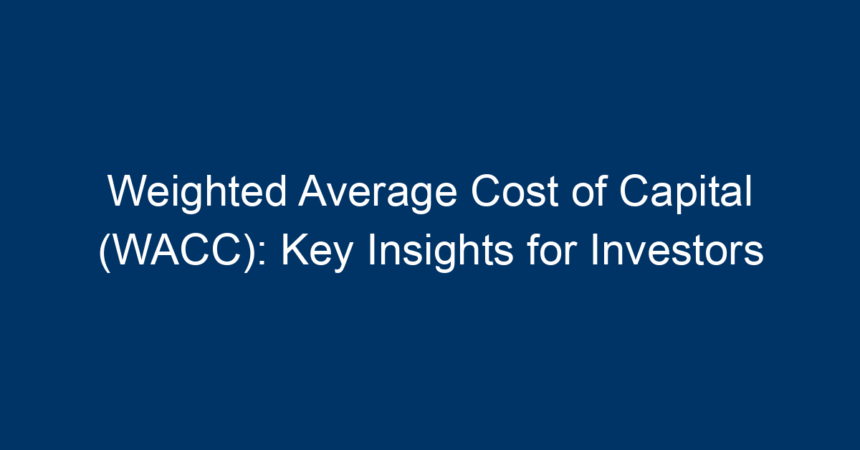In the ever-evolving world of finance, understanding the financial metrics that drive business decisions is crucial for investors. One such essential metric is the weighted average cost of capital (WACC). This key indicator helps investors assess the viability of an investment and the risk associated with financing. In this article, we will dissect WACC, its components, its significance for investors, and actionable insights that can enhance your investment strategy.
What is Weighted Average Cost of Capital (WACC)?
The weighted average cost of capital (WACC) is a financial metric used to assess a company’s cost of capital from both equity and debt components, weighted according to their proportional shares in the company’s capital structure. In simpler terms, WACC tells investors how much a company needs to earn to satisfy its investors and creditors.
Formula for WACC
The formula for calculating WACC is:
[ WACC = \left( \frac{E}{V} \cdot r_e \right) + \left( \frac{D}{V} \cdot r_d \cdot (1 – T) \right) ]
Where:
- ( E ) = Market value of equity
- ( D ) = Market value of debt
- ( V ) = Total market value of equity and debt (E + D)
- ( r_e ) = Cost of equity
- ( r_d ) = Cost of debt
- ( T ) = Corporate tax rate
This formula allows you to see how much it costs the company to finance its operations and investments. But why is this metric so significant?
Importance of WACC for Investors
1. Assessing Investment Viability
For investors, WACC acts as a benchmark against which they can measure the return on investment (ROI) for potential projects or investments. If a company’s expected revenue exceeds its WACC, the investment is likely sound. Conversely, a return lower than the WACC suggests that the venture may not be worth pursuing.
2. Evaluating Financial Health
A lower WACC indicates that a company is employing cost-effective financing. It signifies that the company can return value to its investors while maintaining sufficient capital for growth initiatives. Therefore, monitoring the WACC can provide investors with insights into a company’s financial health over time.
3. Valuation of Companies
WACC is crucial for discounted cash flow (DCF) analysis, a common method for valuing businesses. The WACC is utilized as the discount rate when calculating present values of future cash flows. Thus, an accurate WACC estimation can lead to more precise company valuations and investment decisions.
Components of WACC
Understanding the individual components of WACC is vital for interpreting its overall metric effectively.
Cost of Equity
The cost of equity represents the returns that equity investors expect from their investments. This can be calculated using the Capital Asset Pricing Model (CAPM):
[ r_e = r_f + \beta \cdot (r_m – r_f) ]
Where:
- ( r_f ) = Risk-free rate
- ( \beta ) = Measure of volatility or systematic risk
- ( r_m ) = Expected market return
Cost of Debt
The cost of debt is the effective rate that a company pays on its borrowed funds. It can be calculated using the yield to maturity on existing debt or by assessing current market conditions for similar instruments. Importantly, since interest payments are tax-deductible, the after-tax cost of debt is used in the WACC formula.
Market Value of Equity and Debt
To calculate WACC accurately, it’s essential to determine the market values of equity and debt. The market capitalization of a company (i.e., share price multiplied by total outstanding shares) gives the market value of equity, while the market value of debt can be found through its current trading price or book value.
Factors Influencing WACC
Several factors can influence the weighted average cost of capital for a company:
1. Market Conditions
Economic conditions can heavily impact WACC. For instance, in a low-interest-rate environment, the cost of debt decreases, which may lower WACC.
2. Company Risk Profile
A company’s risk level affects its cost of equity and debt. Higher-risk companies generally face higher capital costs as investors require better returns for taking on that risk.
3. Capital Structure
The proportion of debt to equity in a company’s capital structure impacts its WACC. A firm that uses more debt may have a lower WACC, given the tax advantages of debt financing. However, excessive debt may increase perceived risk and, consequently, the cost of debt.
Real-World Applications of WACC
1. Mergers and Acquisitions
In M&A activities, WACC is crucial for determining the fair value of the target company. An acquirer typically seeks to ensure that its investment exceeds the WACC for optimal returns.
2. Capital Budgeting
For companies undertaking new projects, WACC serves as the hurdle rate for investment decisions. Projects expected to yield returns above WACC are likely to receive funding.
3. Performance Measurement
Organizations use WACC as a performance indicator to evaluate their strategic decisions over time. Shareholders look for consistent returns exceeding WACC as a sign of good management.
Challenges in Calculating WACC
While WACC is a powerful tool, it comes with challenges:
1. Estimating Inputs Accurately
Determining the cost of equity and debt often requires assumptions about market conditions, which can fluctuate.
2. Dynamic Nature of Capital Structure
Changes in a company’s capital structure can alter WACC, necessitating frequent recalculations.
3. Market Volatility
In volatile markets, the risk associated with investments increases, complicating WACC assessments as investor expectations change rapidly.
Conclusion: Actionable Insights for Investors
Understanding the weighted average cost of capital (WACC) can empower investors to make informed decisions. Here are some actionable insights to consider:
-
Leverage WACC as a Benchmark: Use WACC as a threshold for evaluating investment opportunities. Aim for projects that exceed this cost.
-
Monitor Changes Regularly: Keep a close eye on both market conditions and the company’s capital structure, recalculating WACC as needed.
- Incorporate WACC into DCF Models: If you engage in DCF analysis, ensure your WACC calculations are accurate to better value potential investments.
Understanding WACC is not merely an academic exercise; it is a practical tool that can significantly influence investment decisions. By mastering this financial metric, investors can enhance their portfolio management and strategic investments.




